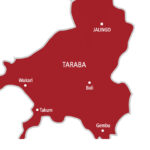Farmers of soybeans in Benue, Katsina, Zamfara and Kaduna states have identified drought as the reason for the poor harvest experienced this year. Although the farmers and other agric experts mentioned other factors, such as high cost of inputs, inability to access fertiliser due to COVID-19 lockdown, etc, they said the long drought experienced in August was the major challenge.
Our correspondent in Benue State gathered from a cross section of farmers that the poor harvest might result to scarcity of the crop in the season ahead.
Stakeholders are worried that the country may witness a surge in the prices of soybeans in the months ahead due to the decrease in production.
It was also noted that any shortage in soybeans would have a disastrous impact on the prices of animal feed, particularly in the poultry industry.
“If a bag of soybeans costs N16, 000 at the peak of production, then we are in trouble when the off-season comes in the coming months,” Dr Hassan Dalha, a farmer and treasurer of the Soybeans Farmers Association of Nigeria told Daily Trust on Sunday in Abuja.
Dr Dalha, who cultivates soybeans in wet and dry seasons, explained why the country must brace up for the difficult days ahead.
He said that in Katsina, Zamfara and Kaduna states, many farmers did not go into production because of the activities of bandits.
A farmer who did not want to be named also said the COVID-19 pandemic affected production as there was restriction of movement. According to him, during this period, many farmers could not access their farms or get labourers to work for them. He added that the crop takes 120 to 140 days before harvest.
He also noted that the Central Bank of Nigeria (CBN), under the Anchor Borrowers’ Programme, did not disburse money to the association on time for this year’s farming season. He said the association had captured farmers’ data in almost 18 out of the 36 states of the federation, with more than 20,000 registered farmers.
“If you have more than 20,000 farmers and they are not on board, are you going to have a plus or minus?” he asked.
While listing other factors, Dr Dalha also pointed to the fact that inputs did not get to farmers on time, a situation he said affected many of them. He also decried the cost of production, which is discouraging many people from soybeans production.
Daily Trust on Sunday gathered from farmers in Keana and Kanje areas of Nasarawa State that many of them decided to abandon soybeans for rice.
Mr Hope Moses Atsevgo, the state chairman of the Soybeans Association of Nigeria, said the late distribution of inputs affected production in many areas of the state. He added that many of them could not accept the inputs because they came late.
A farmer in Ogobia, Otukpo Local Government Area of Benue State, Pastor Sunday Okopi, said the problem of drought first surfaced during the planting season.
“There was drought at the period we were supposed to plant soybeans. And it lasted till the end of August. After that, the ones we planted couldn’t do well. As we speak, they are still flowering.
When we perceived what was going to happen, we dedicated much of the land to cowpea and used three hectares of it for soybeans, which hasn’t turned out well,’’ he said.
Okopi said he planted the best seed, known as 1448, which is popular, even among other soybeans farmers in the Benue South Senatorial District. He added that the lack of adequate rainfall affected the plant.
He expressed fear that the prices of soybeans, which have already gone up in this season of harvest, as compared with last year, would worsen by next year.
Similarly, another soybeans farmer in Mbagen, Gboko Local Government Area of the state, Titus Atondo, expressed mixed feelings over his harvest this year.
He said, “Harvest is not too good this year, but at the same time, it is not too bad. It is moderate when compared with the previous harvest.
“The harvest this year is as a result of the poor and inconsistent rains during the planting period. Although there was consistent rainfall shortly after the planting period, it was of no value to the crop again, and that has led to poor harvest.
“Another issue that was responsible for the moderate or poor harvest is the high cost of fertiliser. It was sold at a minimum of N15,000, and not every farmer could afford it.
“Certainly, it has affected the market price because the poor quantity harvested, the higher the price. When there is poor harvest, the quantity supplied in the market will be low and demand will be higher; hence the price will be higher.’’
Also, a big-time soybeans farmer in Makurdi Local Government Area, Vitalis Tarnongu, said his harvest was very bad.
“This was as a result of the August break. The very time drought commenced was when we were planting soybeans, so the bulk of the seeds could not get sufficient water to germinate.
“More so, due to no rainfall, herbicide could not be effective, thus making weed control difficult. This will have a tremendous negative effect on the market price as most of the buyers may not come out to purchase. The major buyers would divert their attention to either other alternative commodities or other places. The current market price is N150/kg,’’ Tarnongu said.
At the moment, a 50kg bag of soybeans costs between N10,000 and N15,000 in various local markets across the state, as against N5,000 and N6000 it cost this time last year.
Reacting to the development, a consultant agronomist in the Federal University of Agriculture, Makurdi (FUAM), Teryima Iorlamen, blamed climate change for the poor harvest, saying weather is no longer like before.
“That is why we are telling farmers not to stick to what they have been planting. They should be ready to use the materials we have developed for now.
“Just like what happened to cowpea, the materials brought here were not working, so we developed materials for this environment; and that’s what we are using here (Benue). The farmers can get these seeds from FUAM or BARNADA,’’ he assured.
Iorlamen explained that the long drought in August, which lasted for one month, had a devastating effect on soybeans, such that some farmers in the state cultivated an alternative crop, cowpea. He disclosed that even the ones in his personal farm died at the period.
He further explained that most of the improved seedlings the farmers were used to were developed to fit into particular maturity days. He noted that when such production dates reach, the farmers should not expect good harvest.
He suggested that under the situation of uncertainty, farmers would do best to manipulate planting dates. He added that those who planted earlier got it right while some got poor harvest because they mainly didn’t apply the recommended inputs.
He further said the COVID-19 pandemic, which led to a period of lockdown, impacted negatively on farmers who had no purchasing power to procure inputs. And many people did not have access to inputs.
He also identified the closure of borders as a factor that raised the prices of inputs, especially those imported into the country. As a result of this, according to him, demand became high while supply was low.
“Because of the high cost of inputs, farmers could not afford them, so they just left their crops like that. Also, as you know, SSP is recommended for soybeans, cowpea and groundnut, but the Federal Government didn’t bring any to Benue State this year, and that had a negatively impact on the crops.
“Besides, some of the farmers didn’t have access to improved seed because of COVID-19, so they planted grains instead,” Iorlamen said.

 Join Daily Trust WhatsApp Community For Quick Access To News and Happenings Around You.
Join Daily Trust WhatsApp Community For Quick Access To News and Happenings Around You.


